
Thebes, known to the ancient Egyptians as Waset, was an ancient Egyptian city located along the Nile about 800 kilometers (500 mi) south of the Mediterranean. Its ruins lie within the modern Egyptian city of Luxor. Thebes was the main city of the fourth Upper Egyptian nome and was the capital of Egypt for long periods during the Middle Kingdom and New Kingdom eras. It was close to Nubia and the Eastern Desert, with its valuable mineral resources and trade routes. It was a cult center and the most venerated city during many periods of ancient Egyptian history. The site of Thebes includes areas on both the eastern bank of the Nile, where the temples of Karnak and Luxor stand and where the city was situated; and the western bank, where a necropolis of large private and royal cemeteries and funerary complexes can be found. In 1979, the ruins of ancient Thebes were classified by UNESCO as a World Heritage Site.

Tanis or San al-Hagar is the Greek name for ancient Egyptian ḏꜥn.t, an important archaeological site in the north-eastern Nile Delta of Egypt, and the location of a city of the same name. It is located on the Tanitic branch of the Nile, which has long since silted up. The first study of Tanis dates to 1798 during Napoléon Bonaparte's expedition to Egypt. Engineer Pierre Jacotin drew up a map of the site in the Description de l'Égypte. It was first excavated in 1825 by Jean-Jacques Rifaud, who discovered the two pink granite sphinxes now in the Musée du Louvre, and then by François Auguste Ferdinand Mariette between 1860 and 1864, and subsequently by William Matthew Flinders Petrie from 1883 to 1886. The work was taken over by Pierre Montet from 1929 to 1956, who discovered the royal necropolis dating to the Third Intermediate Period in 1939. The Mission française des fouilles de Tanis (MFFT) has been studying the site since 1965 under the direction of Jean Yoyotte and Philippe Brissaud, and François Leclère since 2013.

The necropolis of Draʻ Abu el-Naga' is located on the West Bank of the Nile at Thebes, Egypt, just by the entrance of the dry bay that leads up to Deir el-Bahari and north of the necropolis of el-Assasif. The necropolis is located near the Valley of the Kings.

Tomb KV19, located in a side branch of Egypt's Valley of the Kings, was intended as the burial place of Prince Ramesses Sethherkhepshef, better known as Pharaoh Ramesses VIII, but was later used for the burial of Prince Mentuherkhepshef instead, the son of Ramesses IX, who predeceased his father. Though incomplete and used "as is," the decoration is considered to be of the highest quality.
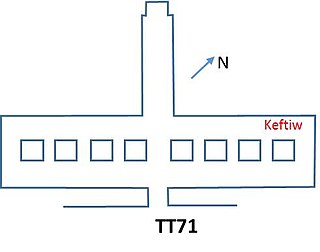
Theban Tomb TT71 is located in the Theban Necropolis, on the west bank of the Nile, opposite to Luxor. It was the tomb chapel of Senenmut, who was the steward and architect of Hatshepsut. The chapel is located in the necropolis area around Sheikh Abd el-Qurna. Previously the tomb was accessible and for most of this time the target of numerous investigations and intrusions, although early on already heavily destroyed. The tomb was visited already early. In the first half of the nineteenth century, John Gardner Wilkinson, Robert Hay and J. Wild copied scenes, although the decoration was already badly destroyed. Richard Lepsius (1842–45) took the false door to Berlin and copied some inscribed bricks. Only in 1906 Kurt Sethe copied all inscriptions. In 1930–31 Herbert Winlock cleared the whole tomb. Winlock found the fragments of a smashed sarcophagus.

Tomb KV10, located in the Valley of the Kings near the modern-day Egyptian city of Luxor, was cut and decorated for the burial of Pharaoh Amenmesse of the Nineteenth Dynasty of Ancient Egypt. However, there is no proof that he was actually buried here. Later, the decoration was replaced with scenes for Takhat and Baketwernel—two royal women dating to the late 20th Dynasty.

The Valley of the Kings, also known as the Valley of the Gates of the Kings, is an area in Egypt where, for a period of nearly 500 years from the Eighteenth Dynasty to the Twentieth Dynasty, rock-cut tombs were excavated for pharaohs and powerful nobles under the New Kingdom of ancient Egypt.
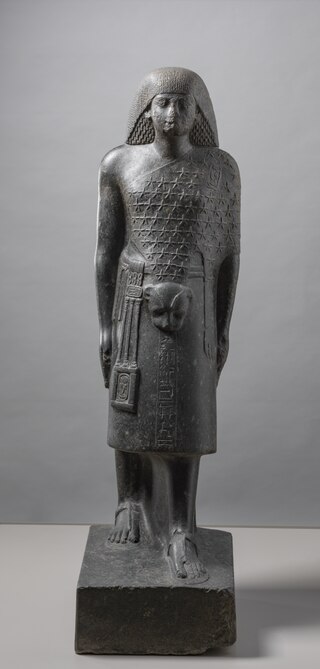
Anen or Aanen was an ancient Egyptian nobleman and official of the Eighteenth Dynasty. A priest and administrator, his period of royal service occurred largely during the reign of his brother-in-law, Amenhotep III.
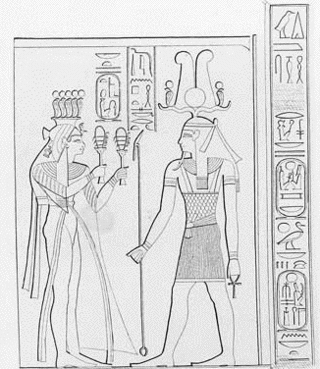
Iset Ta-Hemdjert or Isis Ta-Hemdjert, simply called Isis in her tomb, was an ancient Egyptian queen of the Twentieth Dynasty; the Great Royal Wife of Ramesses III and the Royal Mother of Ramesses VI.

The Theban Tomb TT57 is located in Sheikh Abd el-Qurna. It forms part of the Theban Necropolis, situated on the west bank of the Nile opposite Luxor. The tomb is the burial place of the ancient Egyptian official Khaemhat, who was royal scribe and overseer of double granary, during the reign Amenhotep III. The relief decoration of the tomb is regarded as the best of New Kingdom art.

Simut or Samut was an ancient Egyptian priest who held the position of Second Prophet of Amun towards the end of the reign of Pharaoh Amenhotep III. He is known from a number of objects, including his, Theban tomb chapel Tomb A.24.

The Theban Tomb TT391 is located in South El-Assasif, part of the Theban Necropolis, on the west bank of the Nile, Egypt, opposite to Luxor. It is the burial place of the ancient Egyptian mayor of Thebes and fourth priest of Amun Karabasken, who lived during the reign of the 25th Dynasty pharaohs Piye and Shabaka. The tomb itself was built around 715–705 BCE under Shebitku, and it is the earliest one in South El-Assasif. It was first discovered in 1820 by John Gardner Wilkinson, Robert Hay and James Burton, then by Karl Richard Lepsius; it was reopened in 2001.

The Theban Tomb TT111 is located in Sheikh Abd el-Qurna, part of the Theban Necropolis, on the west bank of the Nile, opposite to Luxor. The tomb belongs to a 19th Dynasty ancient Egyptian named Amenwahsu, who was a Scribe of divine writing of the estate of Amun during the reign of Ramesses II. Amenwahsu was a son of Simut, who was a head of outline draughtsmen, and the lady Wiay. Amenwhasu's wife was named Iuy. She was a songstress of Bubastis.

The Theban Tomb TT156 is located in Dra' Abu el-Naga', part of the Theban Necropolis, on the west bank of the Nile, opposite to Luxor. It is the burial place of the ancient Egyptian Pennesuttawy, who was a troop commander and superintendent of the Southern Desert Lands during the reign of Ramesses II in the Nineteenth Dynasty.
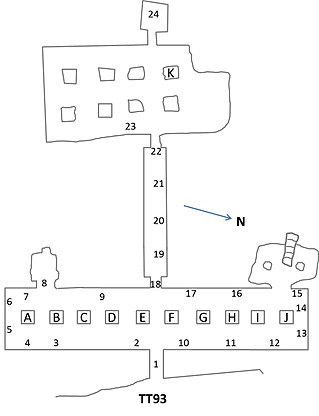
The Theban Tomb TT93 is located in Sheikh Abd el-Qurna, part of the Theban Necropolis, on the west bank of the Nile, opposite to Luxor. The tomb belongs to an 18th Dynasty ancient Egyptian named Qenamun, who was the overseer of the cattle of Amun and chief steward of Amenhotep II. More than eighty epiteths of Qenamun were found in the tomb. Qenamun's mother, Amenemipet, was a wet nurse of Amenhotep II, which effectively made Qenamun a foster brother to the young prince that would become king.
The Theban Tomb C.8 is an ancient Egyptian tomb in Thebes, Upper Egypt. It is located in Sheikh Abd el-Qurna, part of the Theban Necropolis on the west bank of the Nile opposite Luxor. It is the burial place of the ancient Egyptian Nakht, who was the Overseer of the fowl-houses in the Estate of Amun.
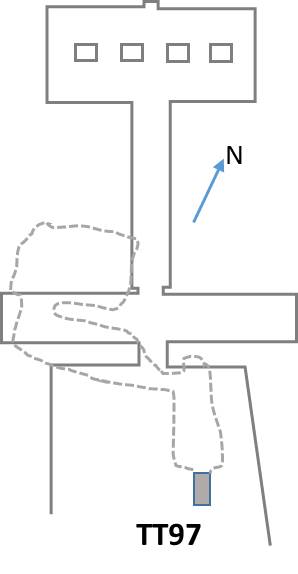
The Theban Tomb TT97 is located in Sheikh Abd el-Qurna, part of the Theban Necropolis, on the west bank of the Nile, opposite to Luxor. The tomb belongs to an ancient Egyptian named Amenemhat, who was the High Priest of Amun at Karnak, during the reign of pharaoh Amenhotep II of the 18th Dynasty. Amenemhat was the son of the wab-priest and "Overseer of the sandal makers of Amun", Djehutyhotep.

Tomb A.6 is the modern number given to a now lost Theban tomb in Dra' Abu el-Naga'. The burial dates to the ancient Egyptian 18th Dynasty and belonged to the overseer of the marshland dwellers Dhjehutinefer, who is also called Seshu. The place was visited by the expedition of Karl Richard Lepsius, who copied the tomb owner's title overseer of the marshland dwellers of the lord of the two lands, but not the name. It seems that the tomb was then already heavily destroyed. Before 1906 the French Egyptologist Henri Gauthier visited A.6 and described the few remains of the decoration and published a short note. Gauthier recorded some further titles of Dhjehutinefer, such as scribe and counter of cattle and fowl of the temple of Amun. A fragment belonging to the tomb is a wall painting that is today in the Metropolitan Museum in New York. On the fragment in New York also mentioned the wife of Djehutinefer, a woman called Benbu. Several funerary cones belonging to the tomb are known. They provide the name of Djehutynefer's father who was the scribe Mesu.
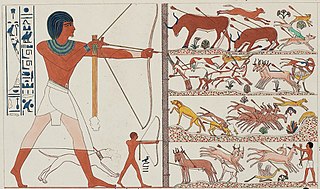
Tomb A.5 is the modern number given to a now lost Theban tomb in Dra' Abu el-Naga'. The burial dates to the Ancient Egyptian 18th Dynasty and belonged to the overseer of the granary of the Lord of the Two Lands, Neferhotep. The tomb was visited by the French traveller Frédéric Cailliaud, who copied and published several scenes. Evidently, he saw the tomb in a fairly good condition and was described by others as superb. The location of the tomb got lost within the Nineteenth century. According to the old drawings published., there are several scenes depicted in the tomb. These include both hunting in the marshes and hunting in the desert, a banquet, and scenes showing vintage and agriculture.
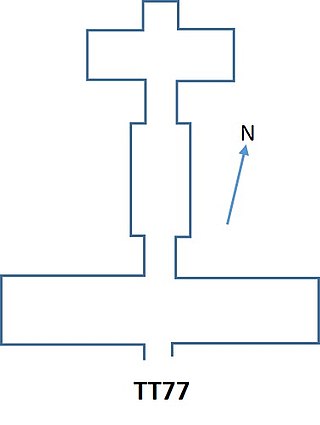
Theban Tomb 77 is located in Sheikh Abd el-Qurna, part of the Theban Necropolis, on the west bank of the Nile, opposite Luxor. It is the burial place of the Ancient Egyptian official named Ptahemhat, who was a child of the nursery, overseer of the works in the temple of Amun, and standard-bearer of the Lord of the Two Lands. The tomb dates to the reign of Tuthmosis IV.



















